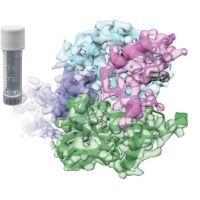Specification
| Organism | Homo sapiens (Human) |
| Expression Host | E.coli |
| Tag Info | Tag-Free |
| Purity | Greater than 95% as determined by SDS-PAGE. |
| Uniprot ID | P40933 |
| Uniprot Entry Name | |
| Gene Names | IL15 |
| Alternative Names | Interleukin-15; IL-15; IL15 |
| Expression Region | Full Length of Mature Protein (49-162aa) |
| Molecular Weight | 12.5 kDa |
| Endotoxin | Less than 1.0 EU/µg as determined by LAL method. |
| Sequence | NWVNVISDLKKIEDLIQSMHIDATLYTESDVHPSCKVTAMKCFLLELQVISLESGDASIHDTVENLIILANNSLSSNGNVTESGCKECEELEEKNIKEFLQSFVHIVQMFINTS |
| Product Form | Lyophilized powder (Lyophilized from a 0.2 μm filtered 20 mM PB, 150 mM NaCl, pH 7.0) |
| Reconstitution | We recommend that this vial be briefly centrifuged prior to opening to bring the contents to the bottom. Please reconstitute protein in deionized sterile water to a concentration of 0.1-1.0 mg/mL.We recommend to add 5-50% of glycerol (final concentration) and aliquot for long-term storage at -20℃/-80℃. Our default final concentration of glycerol is 50%. Customers could use it as reference. |
Background
| Relevance | Human Interleukin 15 (IL-15) is a cytokine that regulates T cell and natural killer cell activation and proliferation. IL-15 binds to the alpha subunit of the IL15 receptor (IL-15RA) with high affinity. IL-15 also binds to the beta and gamma chains of the IL-2 receptor, but not the alpha subunit of the IL2 receptor. IL-15 is structurally and functionally related to IL-2. Both cytokines share some subunits of receptors, allowing them to compete for and negatively regulate each other's activity. The number of CD8+ memory T cells is controlled by a balance between IL-15 and IL-2. Despite their many overlapping functional properties, IL-2 and IL-15 are, in fact, quite distinct players in the immune system. IL-15 is constitutively expressed by a wide variety of cell types and tissues, including monocytes, macrophages and DCs. Mature Human IL-15 shares 70% amino acid sequence identity with Mouse and Rat IL-15. |
| Function | Cytokine that stimulates the proliferation of T-lymphocytes. Stimulation by IL-15 requires interaction of IL-15 with components of IL-2R, including IL-2R beta and probably IL-2R gamma but not IL-2R alpha. |
| Involvement in disease | |
| Subcellular Location | Isoform IL15-S48AA: Secreted, SUBCELLULAR LOCATION: Isoform IL15-S21AA: Cytoplasm, Nucleus |
| Protein Families | IL-15/IL-21 family |
| Tissue Specificity | Most abundant in placenta and skeletal muscle. It is also detected in the heart, lung, liver and kidney. IL15-S21AA is preferentially expressed in tissues such as testis and thymus. |
| Pathway | Jak-STATsignalingpathway |
QC Data
| Note | Please contact us for QC Data |
| Product Image (Reference Only) |  |

